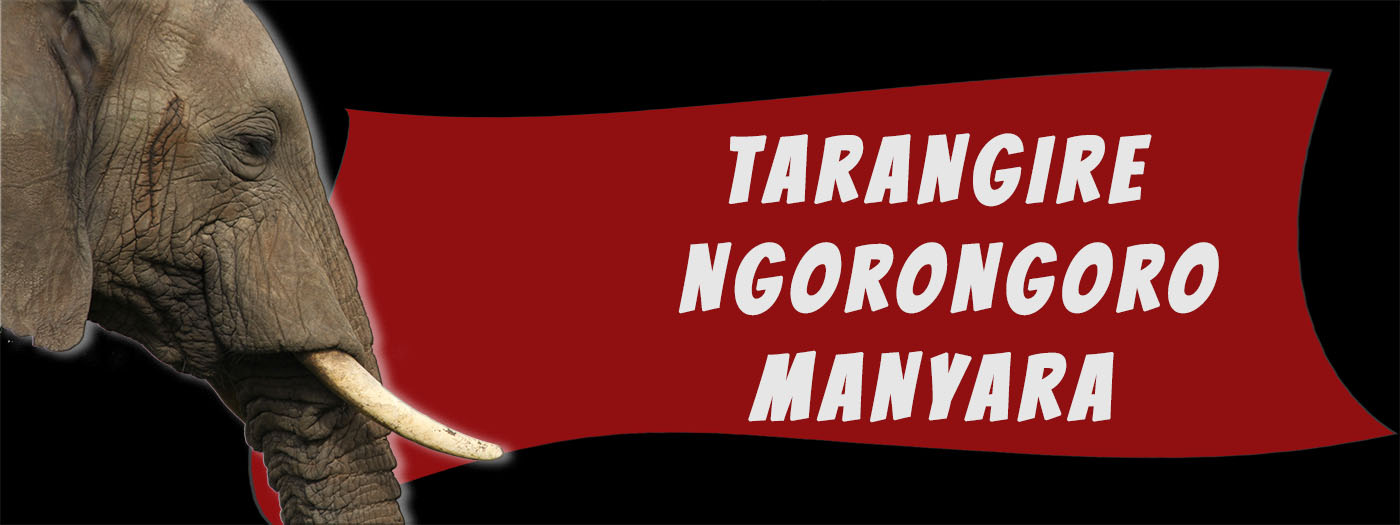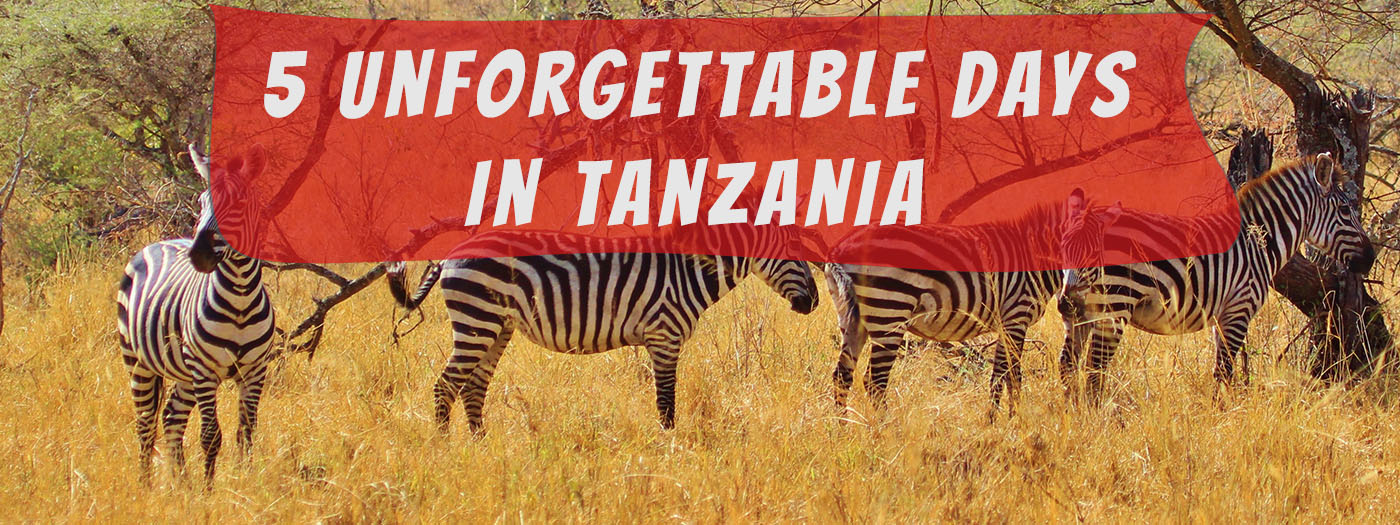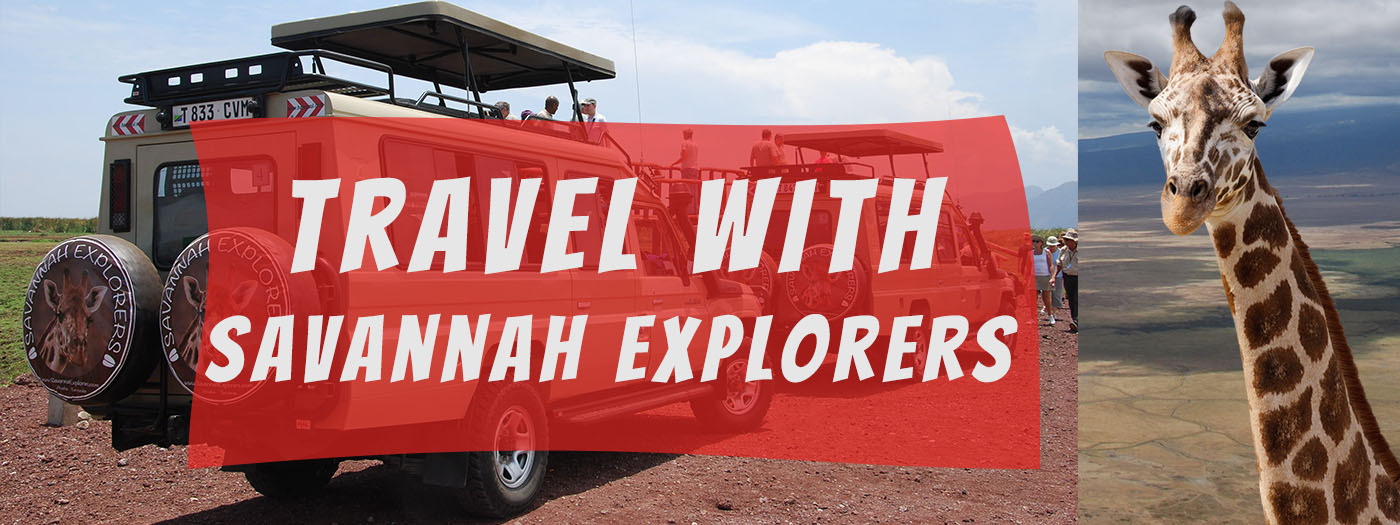Want to depart for an unforgettable vacation? Savannah Explorers offers to you an incredible safari in Tanzania! Five days to visit some of the most beautiful national parks and see the animals of the Savannah face-to-face. Come with us and you will have a personal tour guide, exclusive use of the Jeep, and full board in highly rated lodgings.
Safari in Short
- The trip will last 5 days
- Destinations: Tarangire, Ngorongoro and Manyara
- Activities: game drive and natural walk
- Lunch: pic-nic inside the parks
- Breakfast and Dinner: at Lodge
- Type: Private Safari
- Tour operator based in Arusha
Day 1 - Arrival at Kilimanjaro Airport and transfer to Arusha
After you arrive at Kilimanjaro International Airport, there will be a Savannah Explorers guide waiting for you. After meeting the guide, he will transfer you to Arusha where you will be able to rest in the hotel. If you have time you can visit Arusha and the local market.
Day 2 - Tarangire National Park
The safari starts today with our first game drive in Tarangire National Park, one of the most beautiful Tanzanian Parks. This Tanzanian park is famous for the herds of elephants, the African pythons able to climb on the trees, and the baobab trees.
Day 3 - Lake Manyara National Park
Early in the morning before breakfasts, we experience a bush walk with Maasai guides in the Wildlife Management Area (WMA) next to Tarangire National Park. This area acts as a buffer zone between wildlife habitat and human settlements. After breakfast, we collect picnic lunches and proceed to Lake Manyara National Park for the game drive. The Lake Manyara National Park is one of the parks with the highest biodiversity of flora and fauna. In an area of only 330 kilometers (of which 230 kilometers are occupied by the lake), there are five different ecosystems. The park is inhabited by over 380 types of birds and a big number of animal species, including elephants, buffalos, zebras, giraffes, leopards, lions, baboons, hippos, antelopes, warthogs, and so many others. Later in the evening, we drive to the lodge for dinner and overnight.
Optional Activity: Mto wa Mbu village visit.
Optional Activity: Treetop Walkway.
Optional Activity: Night Game Drive in Lake Manyara National Park.
Day 4 - Ngorongoro Crater
Today we drive to Ngorongoro and descend to the crater where we explore Ngorongoro Crater and the surrounding area. This is one of the most evocative landscapes in the world where we can admire the dormant volcano and the nature that surrounds it. In the park, it will be possible to see the "Big Five:" elephants, buffalos, lions, leopards, and rhinos. However, you should pay attention to the 30,000 animals and a great variety of birds in that area.
Day 5 - Transfer to the airport
After breakfast if we have time we can experience a natural walk, later transfer to the airport.
Optional Activity: Iraqw Boma visit.
Safari Experiences
- Hot-Air-Baloon Safari in Serengeti
- Night Game Drive Safari in Manyara Park
- Visit Masai Boma Village
- Bycicle - trip in the Wild
- Immersive walking tour in the forest
- Walking tour to Lake Duluti
- Horseback riding in Arusha Park
Accommodations
All accommodation types, from safari lodges and hotels to camps, cater for tourists who visit the Ngorongoro crater all year round. Here the accommodations range from budget, mid-range, and luxury. These properties can be divided into three categories; ones located on the Crater Rim, others located on Ngorongoro Highlands, and the rest based in Karatu Village. We highly recommend you stay at the accommodation located on the Crater Rim as you enjoy Crater View just from your accommodation. Some accommodations with amazing Crater view are AndBeyond Crater lodge categorized as a top luxury lodge, Ngorongoro Serena and Ngorongoro Sopa Lodges as normal luxury lodges, and Ngorongoro Wildlife Lodge as a mid-range lodge. These lodges on the Crater Rim are somehow expensive. If you can’t afford to stay here due to budget, we recommend other lodges and camps on Ngorongoro Highlands such as Rhino Lodge and Ang’ata Ngorongoro Camp considered as mid-range. Others are Lemala Ngorongoro and Lion’s Paw Ngorongoro camps as luxury options.
In case your budget can’t fit to stay inside Ngorongoro, then we recommend you stay in Karatu village that is about 40 minutes only drive from Ngorongoro gate. Amazing lodges we recommend found in karatu village are Marera View Lodge as a luxury option, Kudu Lodge and Farm of Dreams Lodge as a mid-range option, and Eileen’s Trees Lodge as a budget lodge. When you stay in Karatu, the price is always cheap because lodges are not expensive there and importantly you don’t pay a concession fee (fee to sleep inside the park). For those who love camping and have an interest to sleep inside Ngorongoro, still, it’s possible. You can do camping at Simba Campsite inside Ngororongo, but be advised that sometimes camping here is rough considering that toilets and showers are shared by all campers. All in all, depending on your itinerary and budget, our safari experts will recommend where is best for you to stay.
Ngorongoro Safari Prices
Price here means the amount of money required to enter the Ngorongoro Conservation Area. Common activity at Ngorongoro is a game drive inside the Crater. Other activities are walking safaris on the Crater Rim and hiking at Olmoti and Empakaai Crater. The known price at Ngorongoro is an entrance fee of 70.8 USD per person and a Crater fee of 295 USD per car. The price is for this year 2021, the Ngorongoro Authority might change it any time, so we advise you to reconfirm the price with your safari expert during the time of booking.
In the meantime, it’s difficult to provide the exact overall price of the Ngorongoro safari as there are several factors that influence the cost of such a safari. Factors considered are the number of people traveling, the type of accommodation you prefer and most importantly where you spend your night. If you sleep in accommodation located inside the Ngorongoro, then apart from the accommodation price, you also pay a concession fee (fee to sleep inside the park). But if you sleep in accommodation located outside Ngorongoro for example at Karatu village, then you save concession fee.
Ngorongoro Crater Weather
Ngorongoro crater has a lower altitude which is around 1700 meters. Precipitation around the crater is about 1000 millimeters (40 inches) per year and is higher compared to other surrounding areas. Due to the lower altitude, the area is more arid and warmer. There is a dry season from June to September which is also the coolest period and the rainy season starts from October to May. Short rainy can be experienced from October to December and long rains are experienced from March to May. Sunshine is good but does not take a long time due to rains which occur in form of showers and thunderstorms with cloudiness which are also formed in the dry seasons.
Things to See and Do in Ngorongoro
We normally refer Ngorongoro as a Garden of Eden due to plenty of attractions found within this protected area. It is one of the best-protected area to spot all the big five animals, that is lion, buffalo, rhino, elephant and leopard. Other animals are like zebras, cheetahs, warthog, wildebeests, jackals, hippos and waterbuck. The main activities around Ngorongoro are game drives, nature walks, bird watching, Maasai Village visit, Olduvai Gorge visit, Laetoli footprint visit, Balloon Safari in Ndutu Area, hiking to the summit of Gol Mountains and Oldonyo Lengai as well as visiting the Empakai and Olmoti craters.
The Ngorongoro Crater
The Ngorongoro Crater is the UNESCO World Heritage Site and the world’s largest intact volcanic caldera commonly referred to as the 8th wonder of the world. It’s about 2,000 feet high walls of the approximately 10-mile wide Crater with a dense population of animals. It’s a breathtakingly beautiful setting and the best place in East Africa to see the Big Five. A visit to this place is an experience of a lifetime as you see many animals in a few hours or a day. The Ngorongoro Crater has high wildlife densities and mostly seen here are Elephants, Lions, Black Rhinoceroses, Leopards, Buffalo, Zebras, Warthogs, Wildebeests, Grant’s, Thomson’s gazelles, and others. In other parks of Tanzania, it’s difficult to spot Black Rhinoceroses but here you have a high chance to see them. The Crater is also home to some bird species especially great flocks of pink flamingos found at Lake Magadi.
Ngorongoro Conservation Area
Ngorongoro is a pioneering experiment in multiple land use, as the park has the multiple purposes of incorporating the protection of nature and of the local people. The harmonies coexistence of both human and wildlife in one area made UNESCO to recognize Ngorongoro Conservation Area as a world heritage site and international biosphere reserve. Ngorongoro Conservation Area is located 180km west of Arusha, with a surface are of 8292 km2 covering the landscape, local people, wildlife and archaeological and paleontological sites.
The protected area was named after the famous Ngorongoro crater, world largest caldera with a depth of around 610m deep, a home of a thousand animal species. Outside the crater, there are interactions between wild animals and the Maasai people with their cattle. Other small crater are Empakai and Olmoti crater that host some of the wildlife species. In addition to the craters and wildlife, Ngorongoro Conservation Area is a home of cultural and aesthetic values. This includes the Olduvai Gorge and Laetoli footprints, which hold important information concerning human evolution.
Ngorongoro Crater Animals
The crater floor supports different animals that can be viewed during game drives the famous one being the big five. The big five are the animals that cannot be hunted down easily, and this includes Rhino, elephant, buffalo, lion, and leopard. Other animals found in the Ngorongoro crater are as follows; hippopotamus, zebra, wildebeest, cheetah, spotted hyena, wild dog, serval cat, black-backed and golden jackal.
Frequently Answer Question About Family Safari
We answer some common questions about family safari and safari in Ngorongoro, if you need more information or have any other question you can contact our office.
When should we travel for our family safari?
We prefer the family to travel in Ngorongoro during the low season from April to May so that to avoid crowds and a budget that is affordable by the family.
How old should my kids be to go on safari in Ngorongoro?
There is no age limit to go for a safari in Ngorongoro except if you book with the lodge that has the age limit for kids.
How much does a family safari cost?
This will depend on the budget of the family, season, and type of accommodation they will use. And since you will be communicating with the tour operator to organize a safari that can be afforded by the family.
Is it dangerous to take kids on safari?
It is not dangerous and it is safer if you have booked with the right camps and right guides. Tour operators will prepare a nice and good itinerary that has a safe and good route for the family to enjoy the safari.
If one gets sick while on safari, how will he or she be treated?
We have AMREF Flying Doctors who are always there to help in case any member of the family needs medical care while on safari.
Which vaccines should the family get before a safari?
For both adults and children no need to take vaccines but we only recommend the family to come with insect repellants.
Apart from game drives, what other activities can a family do?
This will depend on the activities that are provided by the lodge or camp you have booked, but the family can enjoy walking safari and games provided by the accommodation providers.
Is Ngorongoro Crater worth visiting?
Apart from that Ngorongoro Crater is the UNESCO World Heritage Site and the world’s largest intact volcanic caldera. It’s really one of the best places on earth that you should visit when you are on safari in Tanzania. More than 25,000 animals and thousands of Masai pastoralists reside here. Although Ngorongoro is expensive compared to other national parks, it is worth it because here you have a high chance to encounter many animals and especially Big Five animals; Elephant, Buffalo, Leopard, Lion, and Black Rhino that are not easily seen in other Tanzania parks. If you don't have time to waste, then visit Ngorongoro Crater because just one day with 6 hours visit is enough to encounter many animals considering Ngorongoro Crater has high density population of animals. On the other hand, you will find yourself in the middle of traffic jams with other tourist cars but this should not be a problem as you only spend a short time to see many animals. We as safari experts, we strongly recommend this park to anyone visiting Tanzania.
Are there crocodiles in Ngorongoro Crater?
There are no crocodiles inside Ngorongoro Crater due to lack of their preferred habitat but there are plenty of hippos found in Lake Magadi.
How did animals get into Ngorongoro Crater?
Animals in the Ngorongoro crater got into the crater by the attraction from the resources found in it. After descending they got trapped and could not come out again which made them multiply within the crater. Herbivores like zebra, buffalo, antelopes, and wildebeest were attracted to the crater by green grass that was found on the cliff and walls of the crater which made the carnivores like lions, hyena, leopard, cheetah, and jackals who feed on herbivores to follow them. The famous and rare Black rhino were attracted by the lush vegetation found in the crater.
Is Ngorongoro crater or caldera?
Ngorongoro crater essentially it is a caldera that was formed centuries ago when Ngorongoro highland collapsed due to volcanic activities and cause the sinking of the upper part of the highland. The sinking of the upper part is the one that holds thousands of wild animals. The outward explosion of inward materials from a volcano are the one that form craters and they normally support no life of both flora and fauna.
How many lions are in the Ngorongoro Crater?
The Ngorongoro Crater has long been considered one of the best places on earth to see lions. But in 1962, Lions suffered an epizootic disease that reduced the population to nine females and one male. By this year the rain flooded the Crater and surrounding areas and also water streamed down the slopes. Due to this rain, came a plague of biting flies known as stomoxys. The flies tormented the lions, sucking their blood and weakening them beyond repair. Soon the lions began to die off. Just nine females and one male remained. An additional seven males apparently immigrated into the Crater in 1964-1965. But for three decades from 1965, it is believed that no other lions descended into the Crater. The reason counted here is due to either the steep fortress walls of the Crater or by the territorial habits of the pride that grew from those who had survived the plague of flies.
Moreover, by 1975, the population has recovered to its current level of 65-75 animals on the Crater floor, this is according to research done by April 2020. There are eight prides, of which five consist of only 2-3 adult females. The proportion of adult lions, 4 years and older, is 47%. Of those, 38 are cubs or juveniles (less than 3 years old). Last but not least, it’s believed that, although the Crater was probably colonized by Lions from the nearby Serengeti ecosystem but the contemporary Crater lion population shows a significant lack of genetic diversity compared to the Serengeti Lions population.
How did the Ngorongoro Crater form?
Ngorongoro crater is the largest volcanic caldera in the Eastern Rift Valley in northern Tanzania also in the World. It is thought to have been formed about 2.5 million years ago from a large active volcano whose cone collapsed after the major eruption which left the present vast unbroken caldera as it stands now.



